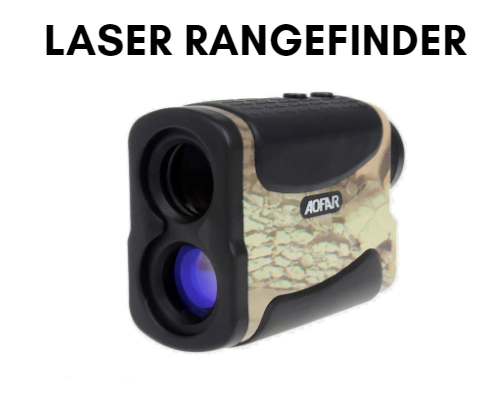A laser rangefinder is an amazing device that has brought a big transformation in the world of hunting, golfing and other activities that require long-distance accuracy. It uses laser technology to measure distances accurately. But have you ever wondered how exactly laser rangefinders work?
In this blog post, we will closely examine how laser rangefinders work and the science behind them. We’ll also discuss the different types of laser rangefinders available on the market. We’ll also talk about why they are so important and how they are constantly evolving to make our lives easier. So, read on for more information.
What is Laser Rangefinder and how does it work?
By measuring the time it takes for the light to travel from the emitter to reflect off the object and return to the rangefinder, the distance can be accurately calculated.

Laser Rangefinders are used in a variety of applications. They can also provide data for mapping terrain, measuring elevation or altitude and providing geodetic coordinates for precise positioning. Laser rangefinders are commonly used by golfers to measure distances between them and various obstacles on the golf course.

Laser rangefinders have a variety of uses in the outdoors, such as measuring distances for hunting, orienteering or scouting. Laser rangefinders can also be used to help make decisions on when and where to take shots with a rifle while hunting.
Basic Principles of Laser Rangefinders
The basic principles behind laser rangefinders involve the emission, reflection and detection of laser pulses. Here are the key principles:
- Time of flight measurement: The rangefinder measures the time it takes for the laser pulse to travel from the device to the target and back. Since the speed of light is known, the rangefinder can calculate the distance by multiplying the time of flight by the speed of light and dividing it by two (as the laser pulse travels to the target and back).
- Emitting laser pulses: The rangefinder emits laser pulses at a specific frequency. These laser pulses are usually in the visible light spectrum but some use infrared lasers, making them invisible to the naked eye.
- Utilizing the Doppler effect: The Doppler effect is the phenomenon in which an object, such as a moving car or an airplane, will appear to have a higher pitch when it’s approaching and a lower pitch when it’s receding. Rangefinders can utilize the Doppler effect by measuring the frequency of the returning laser pulses and using that information to calculate the speed and direction of the target.
- Analyzing the phase shift of the reflected laser beam: Another method of measuring the distance to a target is by analyzing the phase shift of the reflected laser beam.
This process involves comparing two consecutive laser pulses and calculating the difference in their respective phases when they return to the rangefinder. This difference is known as the phase shift and can be used to determine the distance between the rangefinder and the target.
Components of a Laser Rangefinder
A laser rangefinder typically consists of the following components:
- Laser Diode: This is the main source of the laser beam used in the rangefinder. The laser diode emits a highly focused and coherent beam of light. The laser beam is used to measure distance.
- Distance Sensor: The distance sensor detects when the emitted laser beam reflects off an object and measures the elapsed time between sending and receiving this signal.
- Beam Expander: The beam expander is an optical device that takes the laser beam from the laser diode and expands it. This helps to improve the accuracy of the rangefinder by increasing the area that can be measured.
- Optical Filter: The optical filter filters out any unwanted signals or light, such as sunlight or other sources of illumination, so that only a well-defined laser beam is used to measure distance.
- Timing circuit: This circuit is used to measure the elapsed time between when the laser beam is sent out and when it returns to the distance sensor. By comparing this information, the rangefinder can determine how far away an object is.
- Targeting Reticle: The targeting reticle is a crosshair or some other type of symbol that helps the user to focus on a specific target. This helps to ensure accurate and consistent readings.
- Digital Readout Display: The digital readout display shows the calculated distance measurement in real-time. This display can be used to show other readings, such as the angle of elevation or azimuth.
- Power Source: The power source is usually a battery that supplies power to the rangefinder. Batteries may need to be replaced periodically depending on usage and storage conditions.
Overall, laser rangefinders are essential tools for a wide variety of tasks, including surveying and engineering. With the right components, users can achieve accurate measurements at any distance.
Applications of Laser Rangefinders
Laser rangefinders are used by a variety of industries and professions for tasks such as measuring distances, surveying land and engineering projects.
Here are some of the most common applications:
- Military Applications: Laser rangefinders are commonly used in military operations to accurately measure distances between objects or targets. This helps to improve accuracy when firing weapons or communicating with other units.
- Construction and Engineering: Laser rangefinders are used in engineering and construction projects to measure distances between objects for layout and design purposes. This helps to ensure that all components of the project are installed correctly.
- Surveying: Surveyors use laser rangefinders to measure distances between points on land for mapping and land surveying purposes. This helps to accurately measure distances between points without having to physically walk the area.
- Hunting: Hunters use laser rangefinders to determine the distance between their position and a target animal. This ensures that they can accurately make a shot at an appropriate distance for safety reasons.
- Golf and sports: Laser rangefinders are often used in golf and other sports to measure distances between objects such as flags, baskets or net posts. This helps players accurately determine the distance of their shots for better accuracy.
Overall, laser rangefinders have a variety of uses and applications. With the right components and proper use, users can accurately measure distances at any distance.
Advanced Features and Technologies of Laser Rangefinder
Laser rangefinders continue to evolve and become more user-friendly with the implementation of advanced features and technologies. Here are some of the most popular ones:
- Digital Data Storage: Some laser rangefinders come equipped with digital memory cards that allow users to store various measurements and readings. This makes it easier for users to recall and analyze data without having to re-measure every time.
- Rangefinder Program: Many laser rangefinders come with a rangefinder program that allows users to customize their settings and create profiles for various applications. This saves time and makes it easier for users to switch between different tasks without needing to reconfigure the rangefinder each time.
- Angle Compensation: Some laser rangefinders are equipped with an angle compensation feature that allows them to measure distances even when the user is shooting from an elevated position. This helps make distance measurements more accurate and precise.
- Night Vision: Some laser rangefinders are equipped with night vision technology that allows users to measure distances in low-light situations. This makes it easier for hunters or other outdoor enthusiasts to make accurate measurements even when there is limited visibility.
Limitations and considerations of laser rangefinder
Laser rangefinders are incredibly useful tools but they do have some drawbacks and limitations.
Here are some things to consider before purchasing a laser rangefinder:
- Cost: Laser rangefinders can be expensive, depending on the features and technology included. Be sure to research different models and compare prices before purchasing one.
- Accuracy: The accuracy of a laser rangefinder depends heavily on its components and how well it is maintained. Over time, dust or debris may accumulate on the optics which can cause errors in distance measurements.
- Battery Life: Laser rangefinders typically use batteries that will need to be replaced periodically. Be sure to check the battery life of the model you are considering and make sure it is adequate for your needs.
- Size: Some laser rangefinders can be quite large and bulky which may not be ideal for certain applications. Be sure to check the size and weight of the model you are considering before making a purchase.
Laser rangefinders come with a variety of features and technologies that can be tailored to meet your specific needs. However, it is important to consider the cost, accuracy, battery life and size before making a purchase.
Final Words:
A laser rangefinder is a powerful and versatile device used to measure distances accurately and efficiently. By emitting a laser beam and measuring the time it takes for the beam to bounce back, the rangefinder calculates the distance between the device and the target object.
This technology is based on the principles of laser physics, time-of-flight measurement and advanced optics.
Laser rangefinders find applications in various fields, including hunting, golfing, surveying, construction and military operations. They provide users with precise distance measurements, allowing for improved accuracy, safety and decision-making.




